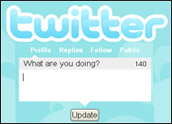
The scenarios jump right out of a Brad Thor or Vince Flynn technothriller novel: Terrorists, using the microblogging service Twitter in conjunction with Google Maps, cell phone video and global positioning system technology, stage an ambush on troops in Iraq or coordinate an attack in an American city. Another terrorist uses Twitter and cell phone video to help remotely detonate a bomb. Yet another terrorist strikes up a Twitter conversation with a U.S. soldier to elicit valuable information.
All three possibilities are at the heart of a 304th Army Military Intelligence Batallion Intelligence report posted late last week to the Federation of American Scientists Web site. The report, dated Oct. 16 and titled “Al Qaeda-like Mobile Discussions and Potential Creative Uses” warns of the dangers in terrorists co-opting various social networking and Internet communications technologies.
“Some of the tactics are old, some of the tactics are still emerging, and some tactics may emerge from hacker, activist and criminal non-terrorist use,” the report says. A list of caveats in the summary portion of the report indicate that the scenarios have not been tested to see they would actually work, some technologies would not be available in certain parts of the world and all the information came from open, unclassified sources.
“What did become clear from conducting research on this topic,” the report states, “is that there are numerous different tactics, tools and software services that can be used by terrorists to conduct activities that go well beyond the original intent of the mobile phone voice communications and that these burgeoning capabilities are available for [open source intelligence] exploitation.”
Don’t Underestimate
“What we’ve found in Iraq is that the people who are fighting us turn out to be pretty sophisticated using commercial technology — more sophisticated than you might think,” James Lewis, director and senior fellow for the Technology and Public Policy program at the Center for Strategic and International Studies, told TechNewsWorld. “They’re doing some reengineering to make these things useful. In that sense, will they look at something like Twitter? Sure, because they’re looking at everything else.”
Paul Ferguson, a senior threat researcher at TrendMicro, takes a more jaundiced approach to the report that is also evident in some blogosphere postings, particularly because of the section that says “Twitter has also become a social activism tool for socialists, human rights groups, communists, vegetarians, anarchists, religious communities, atheists, political enthusiasts, hacktivists and others to communicate with each other and to send messages to broader audiences.”
“It’s a bit ridiculous, because the next thing they’ll discover is that e-mail and blogs can also be used by terrorists,” Ferguson told TechNewsWorld. “It’s something we’ve all known since the dawn of time. The Internet is one of those things that provides connectivity for good things mostly, but also for bad things, and just because Twitter is a microblogging service that seems to be overly popular — to assume that it could be used by terrorists is almost Department of Obviousness.”
Social Networking Terrorists
“In many ways it’s a non-story for me,” Eric Skinner, chief technology officer for Entrust, told TechNewsWorld. “For me the story is — maybe people within the military need to be educated about some of these technologies.” Skinner does admit that the challenge remains for counter-terrorism experts to monitor social networks and tools like Twitter for potential threats without having to employ “ridiculous” restrictions or unlawful eavesdropping techniques.
What about the point raised by the Sept. 11 Commission’s findings that intelligence agencies were guilty of a “failure of the imagination” by not picturing the use of airplanes as missiles? Isn’t Army Intelligence simply trying to imagine all scenarios — even if they skirt the realm of the obvious — to avoid future tragedies?
“That’s a fair point,” Lewis said. “These [terrorist] groups have been very clever in taking commercial technologies and adopting them to carry out their missions.” Lewis believes there’s more credibility in terrorists using social networks for planning, researching and command-and-control functions rather than using them for remote detonations.
“The fact that terrorists are going to use prepaid cell phones, or use encrypted e-mail communications on the Internet, that’s what people need to be worried about, not Twitter,” Ferguson said.


















































